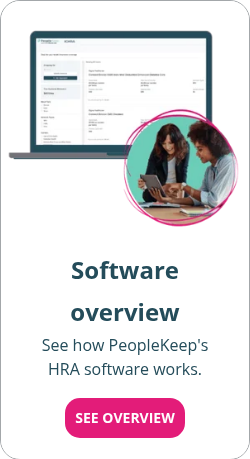HRA administration: What features to expect from your provider
By Elizabeth Walker on November 8, 2024 at 8:00 AM
Health reimbursement arrangements (HRAs) have become popular with U.S. employers because they’re flexible, budget-friendly, and customizable. But like most health benefits, the success and value of an HRA depends on how you administer it. Luckily, an HRA administrator can help.
HRA administration software helps employers of all sizes manage their health benefits quickly and compliantly. But if you’re offering an HRA for the first time, you may not know what features to look for in an HRA administration tool.
In this blog post, you’ll learn:
- What HRA administration software is, and how it helps employers manage their benefits.
- Key features to look for to make an informed decision about which HRA administration tool to purchase.
- How PeopleKeep’s HRA software simplifies the process of offering customizable HRAs.
What is an HRA?
An HRA is an employer-sponsored health benefit that allows employees to receive tax-free reimbursements for qualified out-of-pocket medical costs. Depending on the HRA, these expenses can include individual health insurance plan premiums.
With an HRA, employers give their employees a monthly allowance to spend on healthcare. Once the employee buys an eligible expense, they submit proof of purchase for the service or item. Then, the employer reimburses them tax-free up to their allowance amount.
Only employers can contribute to an HRA. So, employees aren’t responsible for maintaining or funding it. Additionally, any unused funds stay with the employer if the employee leaves the company.
HRAs also have tax benefits. Reimbursements are free of payroll taxes for employers and income-tax-free for employees.
An increasing number of employers are turning to HRAs to offer a health benefit because they are simpler to administer and more cost-effective than traditional group health plans.
What is HRA administration software?
While it may be tempting to administer an HRA yourself, it can become too challenging. Administering an HRA requires in-depth knowledge of IRS, ACA, and ERISA regulations.
HRA administration software helps employers simplify managing their benefits. It can offer compliance support and help with processing employee reimbursements. It generally comes in the form of a cloud-based online tool.
An effective HRA administration platform should make it easy for you or your plan administrator to offer the benefit to your eligible employees. To get the most bang for your buck, you must work with an HRA administrator with expertise and industry knowledge. Check if they have excellent customer support so they can answer any questions you may have.
Here are a few reasons why having HRA administration software is vital:
- Recordkeeping. The IRS requires you to keep employee receipts and invoices for reimbursement requests on file for seven years. HRA software allows you to store all documentation digitally, eliminating the need for paper files.
- The HIPAA Privacy Rule. Under HIPAA, an employee's medical receipts are protected health information (PHI). Your service provider can review your staff’s reimbursement claims to protect you from viewing their private information so you stay compliant with federal law.
- Legal plan documents. Once you design your HRA, the federal government requires you to create legal plan documents. An HRA administration tool can generate custom plan documents and make updates during plan renewal periods, so you don’t have to.
- ACA compliance. HRA administration software can help applicable large employers (ALEs) create a compliant benefit that satisfies the Affordable Care Act’s employer mandate. This saves ALEs from having to buy costly traditional group health insurance.
Some employers may still choose self-administration or manage their HRA with the help of a third-party administrator (TPA). But, HRA administration software is a more cost-effective solution that helps you save time while following federal compliance regulations.
What features should your HRA administration software have?
Choosing the right HRA software is crucial to administrating your benefit effectively and compliantly. But how do you know which is the right one for you? The chart below highlights some key features you should look for when shopping for an HRA administration provider.
|
Feature |
Description |
|
Integrated health insurance shopping |
Employees offered a qualified small employer HRA (QSEHRA) or an individual coverage HRA (ICHRA) may need guidance in selecting coverage that will allow them to participate in their benefit. Your chosen administration software should enable them to shop for an eligible health insurance policy. It should also offer support if they need help. |
|
Compliance |
The IRS requires employers to maintain compliant HRAs. So it’s vital that your chosen software can help you with the following tasks:
|
|
Sending employee communication |
The software should be able to send required employee benefit communications. This includes annual HRA notices and messages about reimbursement requests. |
|
Handling staff changes |
An administration tool should allow you to quickly and easily change your benefit’s eligible employees. This includes adding a new hire to the plan or removing a worker who has left your organization. |
|
User-friendly interface |
Employees should easily be able to complete a wide range of actions on the platform, such as:
|
|
Recordkeeping |
The software should record employee reimbursements and store documentation digitally according to federal standards. |
|
Flexible plan designs |
You should be able to customize your HRA easily. For example:
|
|
Health savings account (HSA) compatibility |
HSAs can work alongside an HRA under specific circumstances. The most common way for an employer to do this is to offer a "limited-purpose HRA.” This HRA only reimburses employees for expenses exempt from the HSA’s deductible. If you want to coordinate an HSA with an HRA, ensure your chosen software allows you to limit expenses to just eligible categories. |
|
Customer support |
Your provider should have a robust customer service team that can support you and your employees throughout the entire process of offering the HRA. |
|
Documentation review |
The IRS requires employees to submit proper claim documentation to receive HRA reimbursements. A good administration software provider can review claim documentation to ensure it complies with federal requirements. This saves you time so you can focus on your business, not reviewing reimbursement requests. |
|
The federal government requires employees with a QSEHRA or an ICHRA to attest that they have proper health coverage on an annual and ongoing basis. They must also attest each time they submit a reimbursement request. The software should allow employees to attest through the platform, by email, or by text. |
How you can administer your HRA with PeopleKeep
PeopleKeep is one HRA administration software provider that specializes in helping small and midsize organizations nationwide offer HRAs. Our user-friendly software makes providing health benefits easier for every industry, budget, and location.
With PeopleKeep’s HRA administration software, you can offer the following types of HRA benefits:
- QSEHRA: This HRA is for small employers with fewer than 50 full-time equivalent employees (FTES). It has annual maximum contribution limits, and employees must have a health plan with MEC to participate.
- ICHRA: This HRA is for employers of all sizes and has no annual contribution limits. Applicable large employers (ALEs) typically leverage this benefit as an ACA-compliant alternative to a group policy. Only employees with a qualifying form of individual health coverage can use the benefit.
- Group coverage HRA (GCHRA): This HRA is for employers of all sizes with a traditional group health plan. With this HRA, employees can get reimbursements for qualified expenses their group plan doesn’t fully cover. Like the ICHRA, there are no annual contribution limits. But, only employees enrolled in your group plan can participate.
PeopleKeep simplifies the process of offering an HRA.
Save time with automated compliance
We automate tedious tasks like preparing and updating IRS-compliant legal documentation. This ensures employers can manage their benefits without the time-consuming administrative burden. Most employers only need about five minutes per month to manage their HRA with PeopleKeep.
Integrated health insurance shopping for QSEHRA and ICHRA
If you’re offering a QSEHRA or ICHRA, your employees can enroll in an individual health plan through their PeopleKeep dashboard. If they need extra assistance, they can rely on a team of licensed advisors to help. This saves employees time and confusion from having to find available plans on their own.
Simple, stress-free reimbursements
Once employees submit a reimbursement request, our team will review their documentation for IRS compliance. We’ll email you when they’re ready for reimbursement. We even have digital storage capabilities for employee receipts. That way, you can find them when needed.
With PeopleKeep, you have complete control over your health benefits. But if you and your employees need help, you’ll have access to our five-time award-winning customer support team every step of the way.
Conclusion
An HRA is an excellent choice for employers seeking a flexible and customizable health benefit. Instead of offering a group plan, offering an HRA allows employers to reimburse employees for qualifying medical expenses. This innovative way of offering health benefits gives employees more freedom to choose their own plans.
But, many small business owners don’t have the time or resources to self-administer their HRA. That’s why using an HRA administration tool is an effective way to keep your HRA running smoothly so you can focus on growing your business.
If you’re ready to offer an HRA, PeopleKeep’s administration software can help. Book a call with one of our HRA specialists today, and we’ll help you make your employee benefits package stand out from your competitors.
This article was originally published on May 7, 2012. It was last updated on November 8, 2024.
Check out more resources
See these related articles

Who is eligible for the individual coverage HRA (ICHRA)?
Find out who qualifies for the Individual Coverage HRA (ICHRA). Explore ICHRA eligibility rules and how they benefit both employers and employees.

What is healthcare reimbursement?
Looking to reimburse your employees for their healthcare expenses? Learn everything you need to know about healthcare reimbursement.

What is the No Surprises Act?
The No Surprises Act protects patients from unexpected medical bills. Learn what it covers, how it works, and what it means for healthcare providers.



